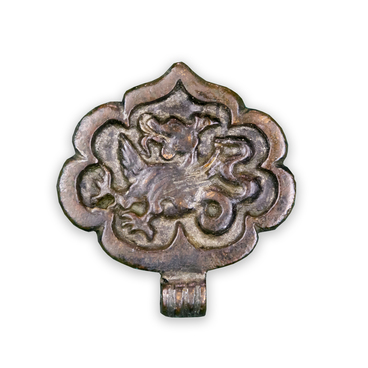The first images of a belt are found in the rock paintings of the Neolithic era — the new Stone Age that began about 10 thousand years ago. Later, in the Middle Ages, there were no pockets, so all necessary things — knives, flint, steel — were hung on the belt.
This accessory was decorated with plates that could indicate the owner’s position in society. Soldiers also used such belts, at that time, they were called “plate-decorated” The higher the position of a man in the army was, the more plates he used and the more complicated and intricate the decorations became. There was a following runic inscription on one of the graves found by archaeologists: “My heroic valor. My belt with forty-two buckles — decorations!” In military uniform, the plates became part of the belt set with a buckle and a special ring, on which a separate belt for scabbard was hung.
There were different types of belt decorations in Volga Bulgaria: rounded, heart-shaped, square, triangular. The plate from the Bolgar Museum-Reserve is four-pointed. According to one version, four points represented Tengri — the supreme god of the Turks and Bulgars. Tengri commanded all the other deities, who were responsible for four forces of nature: fire, water, earth, and air. Another version says that four points meant four seasons. Such a cross-shaped symbol appeared among the Turks about 12 thousand years ago.
Animal figures are cast at the ends of the ledges. Zoomorphic ornaments were found in the Bulgar culture in the pre-Islamic period. Unlike in the Western European tradition, such images were used as decoration, not to intimidate the enemy.
An umbo-shaped ledge is in the center of the plate. An umbo was a spherical eminence at the center of a shield. Under the umbo was a handle to hold the shield. The design protected the warrior’s hand from counterblows.
There are four cylindrical rods on the back of the plate. They were used to attach the metal decoration to a belt. They were put through the holes and bent or flattened on the other side.
This accessory was decorated with plates that could indicate the owner’s position in society. Soldiers also used such belts, at that time, they were called “plate-decorated” The higher the position of a man in the army was, the more plates he used and the more complicated and intricate the decorations became. There was a following runic inscription on one of the graves found by archaeologists: “My heroic valor. My belt with forty-two buckles — decorations!” In military uniform, the plates became part of the belt set with a buckle and a special ring, on which a separate belt for scabbard was hung.
There were different types of belt decorations in Volga Bulgaria: rounded, heart-shaped, square, triangular. The plate from the Bolgar Museum-Reserve is four-pointed. According to one version, four points represented Tengri — the supreme god of the Turks and Bulgars. Tengri commanded all the other deities, who were responsible for four forces of nature: fire, water, earth, and air. Another version says that four points meant four seasons. Such a cross-shaped symbol appeared among the Turks about 12 thousand years ago.
Animal figures are cast at the ends of the ledges. Zoomorphic ornaments were found in the Bulgar culture in the pre-Islamic period. Unlike in the Western European tradition, such images were used as decoration, not to intimidate the enemy.
An umbo-shaped ledge is in the center of the plate. An umbo was a spherical eminence at the center of a shield. Under the umbo was a handle to hold the shield. The design protected the warrior’s hand from counterblows.
There are four cylindrical rods on the back of the plate. They were used to attach the metal decoration to a belt. They were put through the holes and bent or flattened on the other side.

